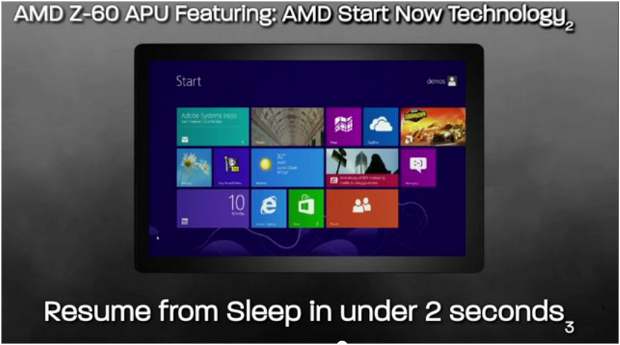Smartphone and tablet chip maker, AMD has announced a new chipset, called Z-60 or Hondo, aimed at Windows 8 tablets and convertibles. AMD has also said that few tablets with its new Hondo chip will be announced alongside the launch of Windows 8 OS on 26th of this month, but it has not revealed the names of the vendors who will manufacture these tablets.
The Chipset is another AMD accelerated processing unit (APU), which combines x86-based central processing with the company’s Radeon-branded graphics technology on a single chip. Hondo is a dual-core, 1 GHz APU featuring AMD’s Bobcat CPU cores and 80 GPU cores worth of Radeon HD 6250 graphics.
AMD claims that the new APU is suitable for tablets with 10 millimeters thickness or more and provides up to eight hours of battery life while web surfing or six hours of HD video playback.
AMD has also included its ‘Start Now’ technology in the chipset for fast boot ups, HD 1080p and HDMI support, and DirectX 11 support for high-performance gaming. There is also support for external monitors to turn the tablet into a sort of PC.
“Tablet users seeking an uncompromised experience for both creating and consuming content on the Microsoft Windows 8 platform now have a performance-driven, affordable option with the AMD Z-60 APU. We see a large gap between the lower performance and high-price competitive offerings that allow AMD to be in tablet designs that will please our customers and end users alike,” Steve Belt, corporate vice president of ultra-low power products at AMD, said in a statement.
Last month, Intel and several OEM (original equipment manufacturers) partners showcased several Windows 8-based tablets and hybrids powered by the chip giant’s new Atom Z2760 chips, also known as Clover Trail. Many of those same partners will also have more powerful Windows 8 products available that sport Intel’s mainstream Core processors.
In comparison to Intel Clover trail, AMD’s battery life claim is shorter by two hours and is thicker than Intel chipset’s 8.5mm thickness. Also AMD Z-60 APU based tablets will have processors with only 1 Ghz dual core rating compared to up to 1.8 Ghz dual core rating of Intel chipset. However AMD is claiming to offer better graphics performance with DirectX 11 support.
Both Intel and AMD also compete with ARM based Processor architectures made by Qualcomm, Samsung, NVidia and TI and many more. ARM dominates the current Android and iOS based tablets with almost 100 percent market share. However ARM based architecture do not support full Windows 8 and there will be a special version for ARM called Windows RT which will not support legacy Windows applications (though there will be a Microsoft office application for that too.
Most Intel based Windows 8 tablets that have been announced so far are expected to sell well above Rs 50,000 price range. And in that sense AMD’s announcement is a welcome move that will make these tablets more affordable.


